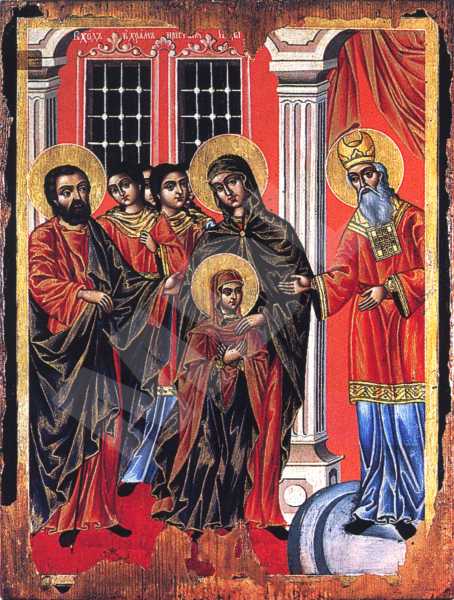The Presentation of the Blessed Virgin
Type:
Icon
Period:
1860 year
Born in 1816 in Bansko, a well-known painter, representative of the Bansko iconographic school. A son of Dimiter T. Molerov. Had been working with his father in 1840-1841 in Rila Monastery, painting the frescoes and the portraits of the donors in the „Saint Nicholas” and the “Saint John of Rila” chapels in the “Nativity of Mother of God” main church. In 1850 had independently painted icons for the iconostasis in the “Holy Trinity” church in Bansko (icons of the Apostle’s and Royal Rows, frescos, etc.). His icons, painted for the “Meeting of the Lord” church in the village of Dobarsko, built in 1860 are among the best achievements of his iconography. In the year 1882 he had painted 46 icons for the “Saint Athanasius” church in the village of Eleshnitsa. In 1883, he had painted icons for the “Saint Dimiter” church in the village of Bachevo. He had made also 30 icons for the “Dormition of the Mother of God” church in the village of Igralishte. In the year 1897 Simeon Molerov had gone to the Holy Mountain and painted in the Kelly of Saints Peter and Paul and in the Zograph Monastery. In 1897 he had been working in Salonika, painting the icons for the “Saint Dimiter” church which had burnt out from a fire in 1913. According to D. G. Molerov’s recollections, Simeon Molerov used to have an icon-painting workshop at Vardar Kapiya in that city. Discerned in his works can be the influence of the Athonity religious painting. He had developed as one of the best painters of his time, with realistic trends in the compositional solution of the icons, contributed to which had most of all his father. In his publication “Iconography in Bansko” Dimiter Georgiev Molerov has this to tell about Simeon Molerov: “…The son of grandpa Miter had been studying to paint icons under his father and had become also a very skillful icon-painter. He had been a complete contrast to his father: a hot-tempered man, dishonorable, ungodly, a drunkard. Had been studying Greek in the town of Serres. When working on an icon, he used to sometimes put his food and wine on it while taking this meal and when he had been reproved, he ised to say this in answer: ‘I am its maker: I may dispose of it as I please!” He had been the first among the old people in Bansko to put on trousers. Had dressed himself carelessly and badly. There were certain women who used to say about him: “With his sleeve so loose and ugly, with his hair so unkempt, how does he manage to make on the icon such well-fitting and heat sleeves and such a nicely-kept hair.’ Having inherited from his father a big fortune in money and property, he had retained fir himself only the real estate and had drunk away all the money. He had inherited a German Bible with illustrations which he had later on sold to Ktse Hadjipopov from Bansko”. Again from D. G. Molerov’s recollections we learn that Simeon Molerov used to have many helpmates, boys from Bansko, whom he had been tr aining in icon-painting. Among them had also been one of the later on eminent iconographers from Bansko, D. T. Sirleshtov. Simeon Molerov’s work has not been completely explored. He had died at the age of 87 in 1903 in Bansko.
Dimmensions (cm):
47
/ 36
/ 2.5
Location
Country: Bulgaria
Province: Blagoevgrad
Village: Dobursko
Church: The Meeting of the Lord
Source
Country: Bulgaria
Province: Blagoevgrad
Village: Dobursko
Church: The Meeting of the Lord
Description
Portrayed in the foreground and in the center is the full-length figure of the young Virgin Mary with arms crossed on her chest. Painted behind her in full length is Saint Anne, with her left hand on Mary's shoulder. The righteous Joachim is portrayed on the left-hand side of the two women-saints, with his arms stretched towards them. Between them are the figures of young maidens, accompanying the Mother of God. In the right-hand side part of the pictorial field is the high priest John, who welcomes the Virgin Mary in the temple. Serving as background of the composition are the elements of the temple edifice: two grooved columns and two windows.
Iconographical technique: Egg distemper
The painting is in the typical of the 19th century style. A smooth texture of the pigment layer. The carnations are painted with evenly and densely laid basic tones (ochre-brown-black). The transitions are finely shaded. The garments of the figures are modelled by means of an evenly and densely applied basic tone, and the line-work is made with liquid gold.
Base material: Wood
The icon's base is a one-piece softwood panel, reinforced with two additionally inserted beams. The ground coat is of plaster, about 0,6 mm thick.
State, restoration traces and comments
There are in several places traces of repairs with black paint.


